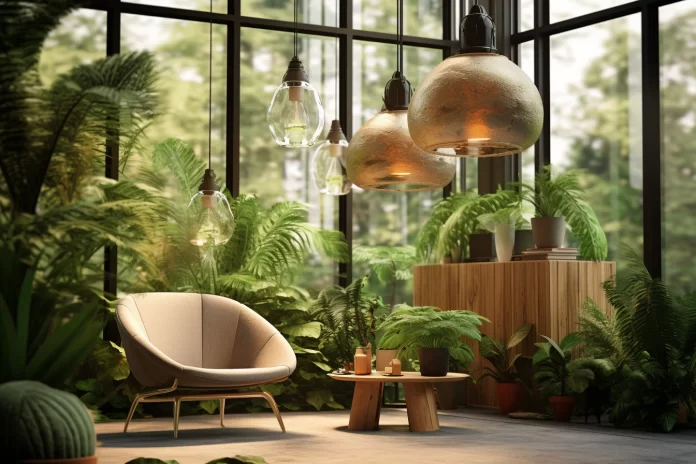Biophilic design is a concept that recognizes the innate human connection with nature and seeks to incorporate nature into our built environments. It is based on the principle that exposure to nature has a positive impact on our well-being. Biophilic design aims to create spaces that mimic nature, utilizing natural elements such as plants, water features, and natural light to promote a sense of tranquility and harmony. By integrating nature into our surroundings, we can enhance our physical and mental health.
The benefits of biophilic design
The benefits of biophilic design are numerous and far-reaching. Research has shown that exposure to nature can reduce stress levels, improve cognitive function, and enhance creativity. Studies have also demonstrated that incorporating biophilic elements into the workplace can increase productivity and employee satisfaction. Biophilic design has even been shown to have a positive impact on physical health, with research indicating that access to green spaces can lead to lower blood pressure and reduced rates of cardiovascular disease.
The role of horticulture in biophilic design
Horticulture plays a crucial role in biophilic design. By incorporating plants into our built environments, we can create a sense of connection with nature. Plants have a calming effect on our minds and bodies, and their presence can help to improve air quality and regulate humidity levels. Horticulture allows us to bring the beauty of nature indoors, creating a more pleasant and inviting atmosphere. Whether it’s a small potted plant on a desk or a lush vertical garden on a building facade, plants can have a transformative effect on our surroundings.
Creating green spaces and integrating nature into design
Creating green spaces and integrating nature into our design is essential for successful biophilic design. Green spaces can take many forms, from parks and gardens to rooftop terraces and indoor atriums. These spaces provide a respite from the concrete jungle and offer an opportunity to connect with nature. Integrating nature into our design can be achieved through the use of natural materials such as wood, stone, and water features. By incorporating these elements, we can create a sense of harmony and balance that is reminiscent of the natural world.
The impact of green spaces on human well-being
Green spaces have a profound impact on human well-being. They provide a place for relaxation, exercise, and social interaction. Research has shown that spending time in green spaces can reduce stress, improve mood, and enhance cognitive function. Green spaces also have a positive effect on physical health, with studies indicating that access to nature can lead to increased physical activity and reduced rates of obesity. By incorporating green spaces into our communities, we can create environments that promote both physical and mental well-being.
The importance of plants in biophilic design
Plants are an integral part of biophilic design. They provide a connection to nature and offer a range of benefits. Plants help to improve air quality by filtering out pollutants and releasing oxygen. They also regulate humidity levels, creating a more comfortable and healthy indoor environment. In addition, plants have a calming effect on our minds and bodies, reducing stress and promoting relaxation. Whether it’s a small potted plant or a lush green wall, incorporating plants into our spaces is essential for successful biophilic design.
Incorporating agriculture and gardens in biophilic design
Incorporating agriculture and gardens into biophilic design is a powerful way to connect with nature and promote sustainability. Community gardens, rooftop farms, and urban agriculture projects allow people to grow their food and reconnect with the natural world. These projects not only provide access to fresh, healthy produce but also create opportunities for social interaction and education. By incorporating agriculture and gardens into our design, we can create spaces that nourish both our bodies and our souls.
Choosing the right plants for your biophilic design
When choosing plants for your biophilic design, it’s essential to consider factors such as light levels, temperature, and maintenance requirements. Different plants have different needs, so it’s important to select species that are well-suited to your specific environment. Consider the amount of natural light available, as well as the temperature and humidity levels in your space. Choose plants that are low-maintenance and can thrive in the conditions you can provide. By selecting the right plants, you can create a vibrant and healthy biophilic design.
Considering climate and location in biophilic design
Climate and location play a crucial role in biophilic design. It’s important to consider the native flora and fauna of your region and incorporate them into your design. Native plants are well-adapted to the local climate and require less maintenance and water. By using native species, you can create a design that is not only beautiful but also sustainable. Consider the specific conditions of your location, such as temperature, rainfall, and soil type, and select plants that can thrive in these conditions. By working with nature rather than against it, you can create a biophilic design that is in harmony with its surroundings.
Incorporating biophilic design in weed horticulture
Incorporating biophilic design principles in cannabis horticulture entails embracing nature-inspired elements to create a more sustainable and harmonious growing environment. By integrating features such as living walls, natural light, and greenery, cultivators can foster a connection with nature within their horticultural spaces, thereby promoting plant health and overall well-being. Growers Choice Seeds cannabis seeds serve as a fundamental component for implementing biophilic design in cannabis horticulture, offering a diverse selection of high-quality autoflowering seeds that enable cultivators to establish an environment where plant life thrives amidst natural elements, aligning with the ethos of biophilic design.
The application of biophilic design in cannabis horticulture goes beyond aesthetics, as it can also contribute to creating a more sustainable and productive cultivation space. Incorporating elements like natural ventilation, organic planting materials, and water features not only enhances the visual appeal of the growing environment but also promotes ecological sustainability and biodiversity.
Implementing biophilic design in different settings
Biophilic design can be implemented in a wide range of settings, from residential homes to office buildings, schools, and hospitals. In residential settings, consider incorporating plants and green spaces both indoors and outdoors. Create a balcony garden or a rooftop terrace where you can relax and connect with nature. In office settings, introduce plants into the workspace to improve air quality and create a more pleasant environment. In healthcare settings, create healing gardens and outdoor spaces where patients, staff, and visitors can find solace and rejuvenation. By implementing biophilic design in different settings, we can create spaces that enhance well-being and promote a sense of connection with nature.
Case studies of successful biophilic design projects
There are numerous examples of successful biophilic design projects around the world. One such project is the Amazon Spheres in Seattle, Washington. These three glass domes house more than 40,000 plants from over 400 species, creating a lush and vibrant indoor oasis. The Spheres provide Amazon employees with a unique space for relaxation, collaboration, and inspiration. Another example is the Singapore Botanic Gardens, a UNESCO World Heritage Site. The gardens encompass 82 hectares of lush greenery and feature a wide variety of plant species. They offer visitors a chance to escape the hustle and bustle of the city and immerse themselves in nature. These case studies demonstrate the transformative power of biophilic design and its ability to create spaces that enhance human well-being.
The future of biophilic design and horticulture
The future of biophilic design and horticulture is bright. As our society becomes more aware of the importance of nature in our lives, there is a growing demand for biophilic design principles. Architects, designers, and urban planners are incorporating biophilic elements into their projects, creating spaces that promote well-being and sustainability. In addition, horticulture is becoming more accessible to people of all backgrounds, with community gardens and urban agriculture projects popping up in cities around the world. As we continue to recognize the benefits of biophilic design and horticulture, we can expect to see more green spaces and nature integration in our built environments.
Conclusion
Biophilic design and horticulture offer a powerful solution to the disconnect between humans and nature in our modern world. By incorporating nature into our built environments, we can create spaces that enhance our well-being and promote sustainability. Whether it’s a small potted plant on a desk or a sprawling urban garden, integrating nature into our design has numerous benefits for our physical and mental health. By understanding the principles of biophilic design, considering climate and location, and choosing the right plants, we can create spaces that inspire and rejuvenate. The future of biophilic design and horticulture is promising, and as we continue to embrace these principles, we can create a more harmonious and sustainable world.



